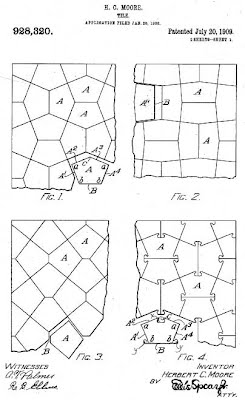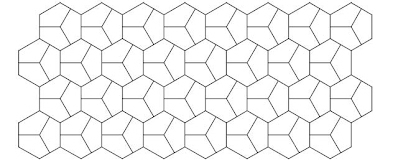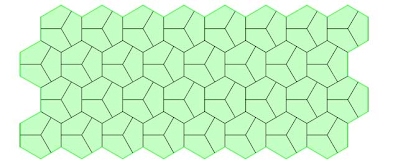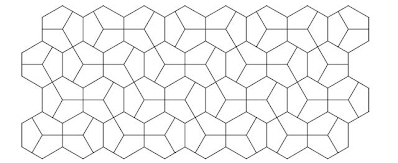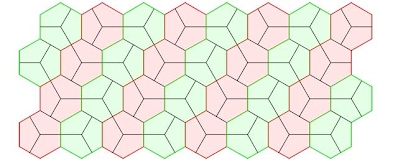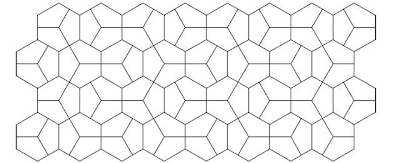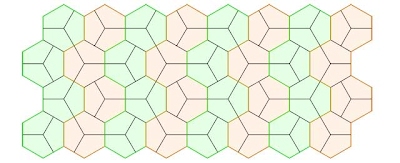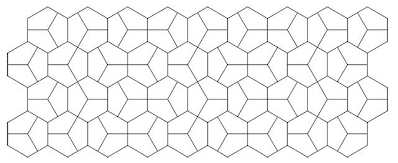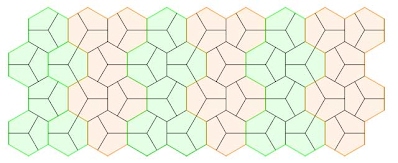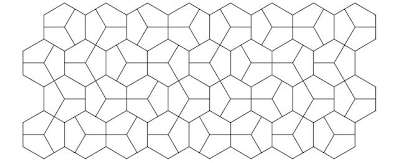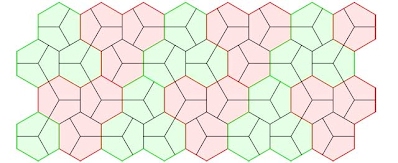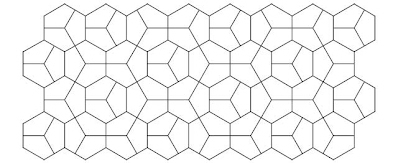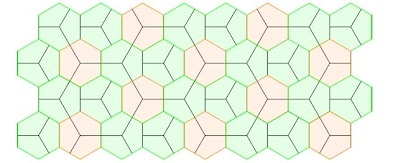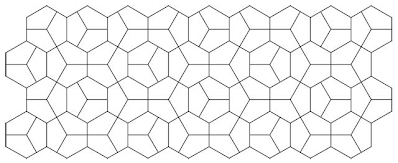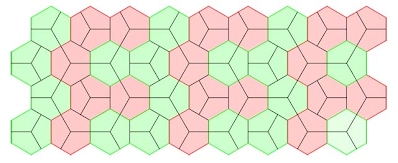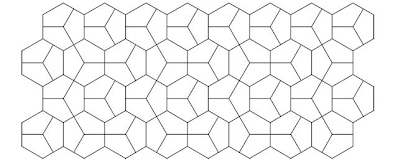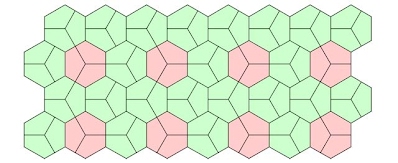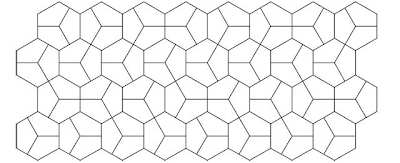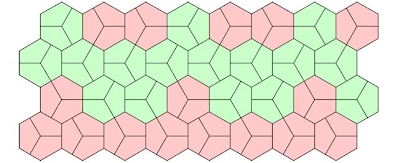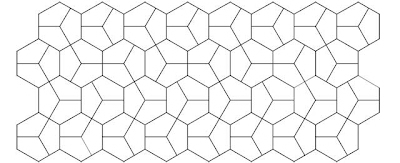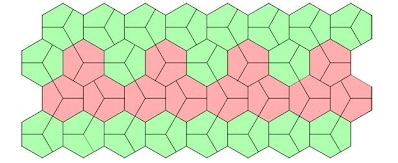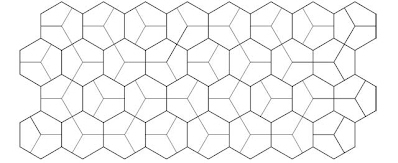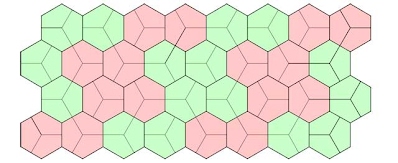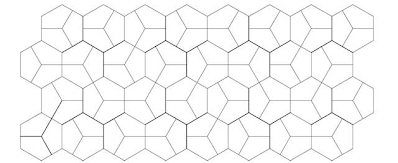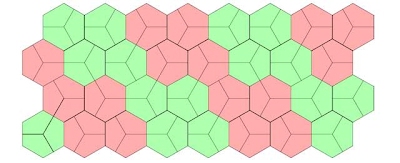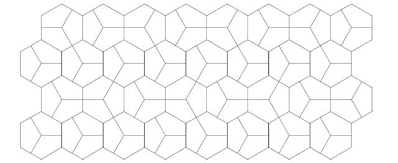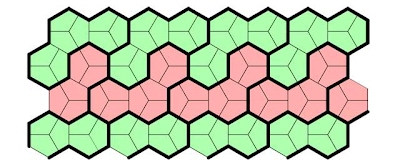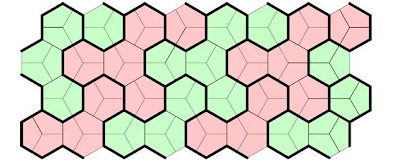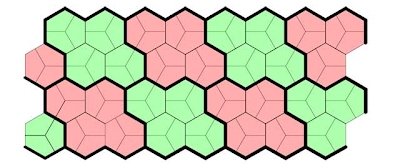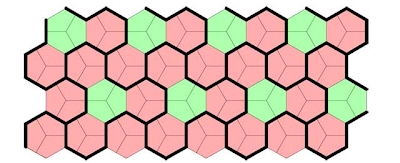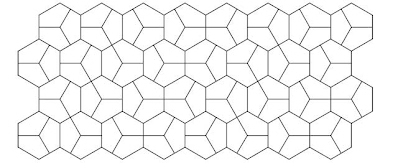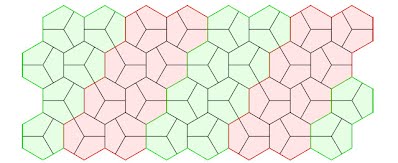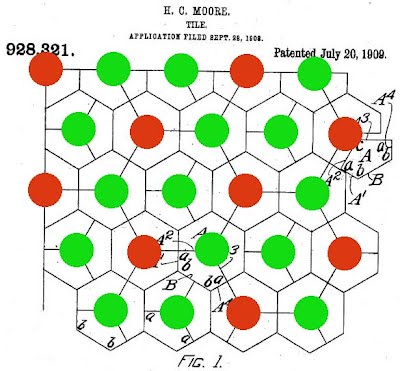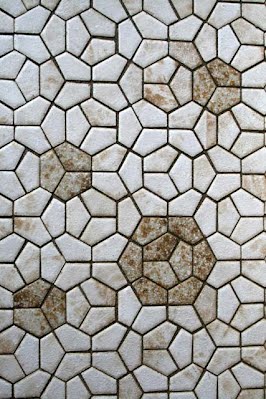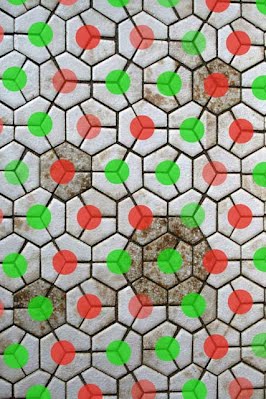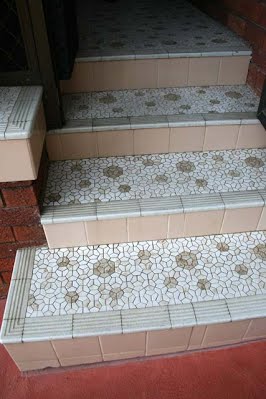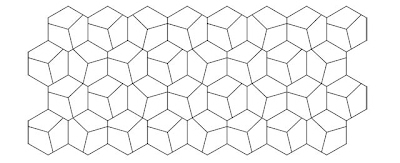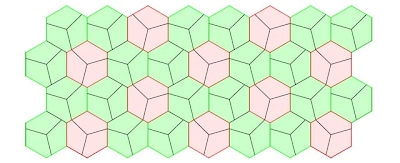Introduction Moore Patent Moore Background Moore Pentagon As this is the apparent
first recorded instance of this tiling (does any reader know of an earlier
example?), I now propose to honour Moore by describing this as a ‘Moore pentagon’. Moore shows but a single tiling, although
there is much more to than this. Regarding the pentagonal tiling shown, this
can be described as consisting of a regular hexagon and subdividing into three
symmetrical pentagons, with sides of three different lengths. Another way of
looking at this is of an order three ‘spoke’, the ends meeting on the mid point
of a regular hexagon. Of interest is that the ‘spoke’ can be ‘placed’ inside
the hexagon in two different ways, thus giving six different orientations of
the pentagon. Moore’s tiling show a combination as described above. Such a combining adds more interest to the possibilities. As might be imagined, with two possible placements, more than a single tiling is possible, of which Moore, although he must have been familiar with the possibilities does not discuss. Indeed, despite this being so obvious, he does not even mention anything about further tilings, or indeed hexagons! Moore’s two tilings (1909) is of significance historically, of which I believe this to be the first such ‘proper’ study of pentagon tilings, albeit the treatment is indeed lightweight. Moore predates Reinhardt by nine years, although their respective efforts are not to be compared in depth, with Reinhardt being incomparably the better mathematician, and looking at the problem in depth. Moore’s contribution is most limited, of two ad hoc instances, without thought as an all-encompassing approach. Nonetheless, Moore deserves much credit for being the first to at least look at pentagon tilings. I am unfamiliar to any reference to Moore in the pentagon tiling literature; his work seems to have been ignored, likely due to the means of his patent publication (although referred to in Sir Roger Penrose’s now famous Penrose tile patent of 1975), of which only recently, in the internet age, has such patent searching become practical. Does any reader know of any earlier instances of convex pentagon studies? Studies Upon
correspondence with George Baloglou, with an shared interest in pentagon tiling, in
which upon myself bringing this to his attention he urged me to study this
tiling, I have recently looked at the possibilities, and of which I have drawn
two main findings: Consequently, of perhaps the most interest is to determine a number of non-trivial ‘core’ examples, some of which I show below, beginning with the simplest, and gradually increasing in complexity. The definition of ‘core’ possibilities is left in a loose, ill-defined state; there is no hard dividing line, I could continue with further tilings. These are in two forms: left, a wireframe diagram, and right, a colour-coded construction, based on the two placements of the spoke. This brings out the underlying structure much better. These are all shown in a relatively small format, of a linear block in an 8 x 4 array, as judged best to better show the construction in a ‘balanced’ manner. Bailey Analysis Figures 1a, 1b Figures 2a, 2b Figures 3a, 3b Figures 4a, 4b Figures 5a, 5b Figures 6a, 6b (this is the arrangement as given by Moore) Figures 7a, 7b (this is the arrangement as given by Dunbar) Figures 8a, 8b Figures 9a, 9b Construction Principles As such, there are a variety of ways of constructing the tilings. Below I show what I term as my 'Polyhex' method. See Figures 10 and 11 Principle of doubling-up of strips Figures 14a, 14b Fig. 14 shows the principle of increasing unit strip widths rather than being at the tail end of 'complex'. Moore Arrangement Analysis Figure 15: Moore Arrangement Analysis Dunbar Analysis Also of interest is of instances of the pentagon as a real-world tiling. One instance has been found, courtesy of Bev Dunbar and her colleague Chrissy Monteleone, of whom I am indebted for the following information. The photo shows the pentagon used to decorate steps on a veranda in Earlwood, Sydney, Australia, dated about the 1960s. Unfortunately, the tiles no longer exist; the veranda has been renovated since the photograph was taken. Consequently, the background to this is not known. As can be seen, the analysis (overlaid with red and green dots for the sake of expediency) gives a relatively complex arrangement, shown as Figure 7 on my examples. Of note is the tiles are placed individually, without colour as a guide, save for the curious brownish seemingly random additions, so the tiler must have been working from a pattern book. Given its relative complexity I can only think that a mathematician is behind this. Also of note is how small the tiles are, indeed tiny; what a fiddly job it must have been to lay! Note that the pictures (a) and (b) ‘as shown’ has incorrect perspective; as taken, in a (correct) horizontal position, the hexagons are of the ‘other’ orientation; for the sake of consistency with the diagrams on this page I have rotated the image 90° to match. History Doubtless, it will have occurred in other books, including my own library that I not yet searched through. Can any reader give any examples? Ideally, the earlier the better. Also, I would be interested in seeing any other ‘arrangements’ as shown above. It seems hard to believe that there would not be such studies, but upon web searching I have not been able to find anything. Yet another aspect to this is colouration, of which for now at least I have not found the time to study. In association with George Baloglou, whose field this more is, I hope to show some examples in due course. George Baloglou Colourings The following minimal perfect colourings of the Moore-like tilings presented above are contributed by George Baloglou, with special emphasis -- and nine colourings, not necessarily mathematically distinct -- on Moore's original tiling.For more background detail on these, see:
Reinhardt Variations Specifically, the Moore pentagon can be described as a special case of a Type 3 convex pentagon (of a series of 14 types, which is still not proven as complete), in that it is symmetric, as against other type 3 pentagons, which are asymmetric. (Likewise, the first tiling shown above is a special, more symmetric, case of Reinhardt's Type 3 tiling.) A full listing of the types is at: http://www.mathpuzzle.com/tilepent.html Also, an interactive demonstration can be found here: Figures 17a, 17b: Reinhardt pentagon variant As George Baloglou observes, although Moore's tiling requires six colours for a perfect colouring, this less symmetrical version (Fig.17c) admits a perfect colouring in four colours Created 5 November 2014. Revised 21 November 2014, with Reinhardt investigations, Dunbar Figure 16. 24 December 2014 Figures 10-13. 11 March 2015. 20 April 2015 Revised with George Baloglou colourings. 17 August 2020. Added corrections, as according to George Baloglou's suggestion. |
